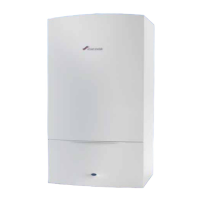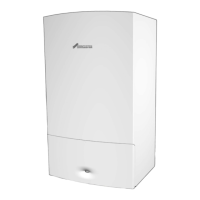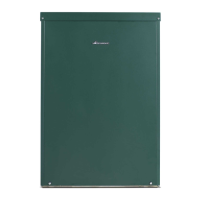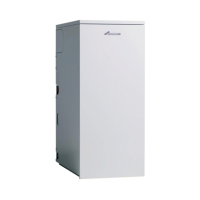PRE-INSTALLATION
CDi Compact
ErP
- 6 720 813 276 (2015/07) 15
4.4.1 Internal connections
In order to minimise risk of freezing during prolonged cold spells, the
following methods of installing condensate drainage pipe should be
adopted, in order of priority.
Wherever possible, the condensate drainage pipe should be routed and
terminated so that the condensate drains away from the boiler under
gravity to a suitable internal foul water discharge point such as an
internal soil and vent stack. A suitable permanent connection to the foul
waste pipe should be used.
Fig. 5 Disposal to soil vent stack
Alternatively if the first option is not possible an internal kitchen or
bathroom waste pipe, washing machine waste pipe etc. can be used.
Ensure that the condensate drain pipe is connected “down stream” of
the waste trap.
Fig. 6 Disposal to a waste pipe
CONDENSATE PUMP
Where “gravity discharge” to an internal termination is not physically
possible, or where very long internal runs would be required to reach a
suitable discharge point, condensate should be removed using a
proprietary condensate pump, of a specification recommended by the
boiler or condensate pump manufacturer.
The pump outlet pipe should discharge to a suitable internal foul water
discharge point such as an internal soil and vent stack, internal kitchen
or bathroom waste pipe, washing machine waste pipe etc. A suitable
permanent connection to the foul waste pipe should be used.
Fig. 7 Condensate pump disposal
4.4.2 External connections
If no other discharge method is possible then the use of an externally run
condensate drainage pipe terminating at a suitable foul water discharge
point, or purpose-designed soak away, may be considered. If this
method is chosen then the following measures should be adopted:
▶ Use a CondenseSure siphon to help prevent the condensate freezing.
▶ The external run be kept as short as possible and not exceed 3
metres.
▶ The pipe should be run internally as far as possible before going
externally and the pipe diameter should be increased to 32mm
before it passes through the wall to the exterior. The pipe should be
insulated using suitable waterproof and weather resistant insulation,
if not using a CondenseSure siphon.
▶ The external pipe should take the shortest and least exposed route to
the discharge point, and should "fall" as steeply as possible away
from the boiler, with no horizontal runs in which condensate might
stand.
2
22mm Ø
1
3
6720644744-06.3Wo
100mm
75mm
min.
4
5
6
1
22mm Ø
6720644744-07.3Wo
NOTICE: Freezing conditions
▶ When the position of the boiler prevents internal
routing, we recommend installing a CondenseSure
siphon to significantly reduce the risk of freezing.
▶ Pipe work length should be kept to a minimum and
the route as vertical as possible.
▶ Weather proof insulation must be used, if not using a
CondenseSure siphon.
NOTICE: Condensate waste
▶ Care should be taken when siting a soak-away to
avoid obstructing existing services.
Continued - Key to condensate illustrations
8 PVCu strap on fitting
9 100mm Ø minimum plastic pipe
10 Drainage holes
11 Limestone chippings
12 Bottom of sealed tube
13 Insulate and increase pipe size
14 Pipe work transition
15 External air break
16 Air gap
17 External rain water pipe into foul water
18 43mm 90° male/female bend
* Condensate trap of 75mm already incorporated into the boiler
75mm
min.
4
7
5
6
1
22mm Ø
6720644744-08.3Wo
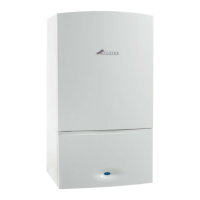
